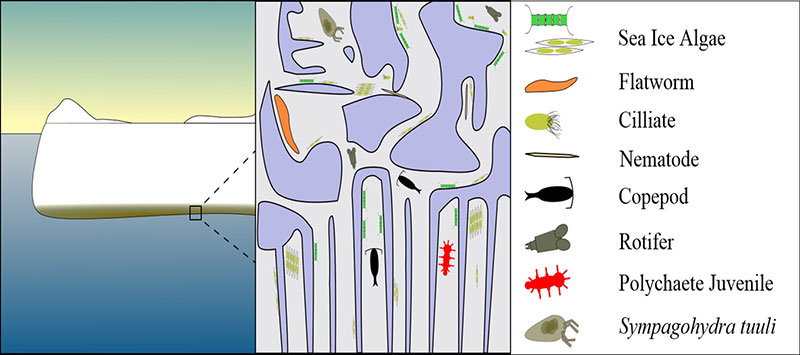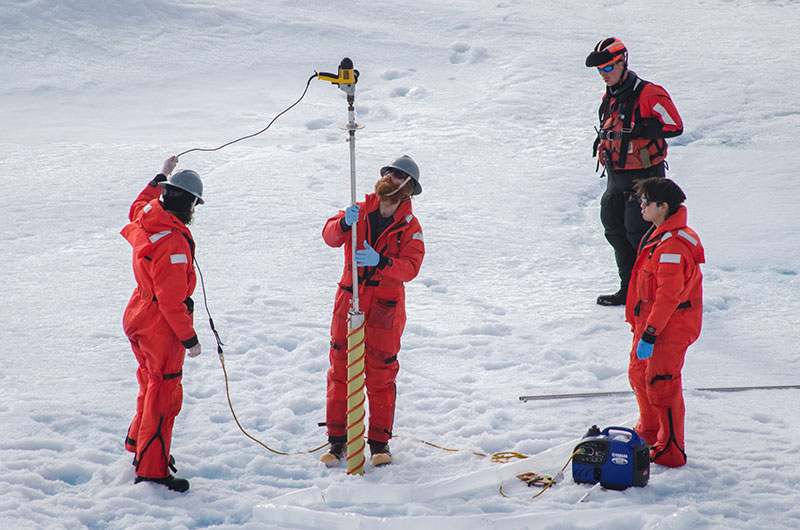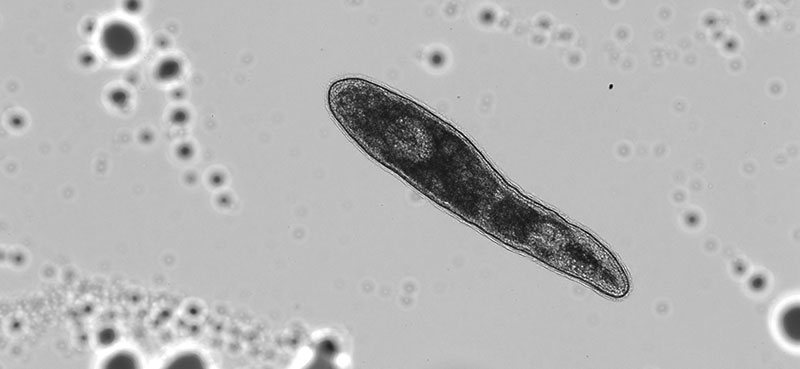
By Kyle Dilliplaine, University of Alaska Fairbanks, Graduate Student
July 16, 2016

The ice team, consisting of Dr. Eric Collins, Kyle Dilliplaine, and Brian Ulaski, is lowered in a man basket to the ice below from the deck of the Healy. Image courtesy of Caitlin Bailey, GFOE, The Hidden Ocean 2016: Chukchi Borderlands. Download larger version (1.1 MB).
Sea ice is a unique substrate to sample. It is a composite material comprised of freshwater ice crystals permeated by hypersaline (very salty) “brine.” As a biologist, I study the organisms that occupy the brine channel system (BCS).
The BCS, formed during ice formation as ions are rejected from the ice matrix, acts as a refuge and medium for microbial communities, phytoplankton, and larger metazoans. The brine remains liquid at sub-zero temperatures and provides the habitat for our target organisms to occupy. The BCS can be likened to the pore water of marine sediments and both environments foster similar biological communities.

Cartoon depiction of the brine channel system (BCS) occupied by sympagic algae and meiofauna. Graphic courtesy of Kyle Dilliplaine, UAF, The Hidden Ocean 2016: Chukchi Borderlands. Download larger version (156 KB).
Traditional ice sampling is done by coring the ice. During this cruise, we are using a nine-centimeter inner diameter corer attached to an electric drill to remove cores from the ice floe. After a core is retrieved, samples are immediately sectioned using hand saws in the field, if time permits, or brought back to the boat for processing there.
Sectioning of the core gives us a picture of the ice consistency and the biological community along the vertical profile throughout the ice column. So far, our time on the ice has been extremely limited, so ice samples have all been processed in the laboratory back aboard U.S. Coast Guard Cutter Healy.
Our typical sampling regimen includes physical and chemical measurements of the ice in addition to the biological sampling. Ideally, we collect cores for temperature, bulk salinity (direct melting of ice sections), nutrients, oxygen isotopes, chlorophyll a, algae, meiofauna, and genomics.

Dr. Eric Collins handles the corer with Kyle Dilliplaine and Brian Ulaski. The collected ice cores can be seen in the plastic tubing at the bottom of the frame. Photo courtesy of Caitlin Bailey, GFOE, The Hidden Ocean 2016: Chukchi Borderlands. Download larger version (2.1 MB).
Each sample will tell us something about the ice or its inhabitants. The temperature and bulk salinity, together, tell us about the brine salinity, which can be seven times greater than normal seawater, and how much of our ice sample was liquid brine at the time of collection. Nutrient measurements tell us what is available for algal and microbial production while oxygen isotopes can tell us about the source water of the ice, i.e., if there was riverine input at the time of freeze-up.
To prevent cell lysis when processing the biological cores, we add filtered seawater to each of the sections to help raise the salinity of the water as the ice melts. Chlorophyll a is a standard oceanographic measurement of algal biomass; we supplement these data by preserving algal samples for later taxonomic identification and enumeration.

Monochromatic light micrograph of an unidentified flatworm, a member of the meiofauna, collected from the bottom three centimeters of a multi-year ice floe. Photo courtesy of Kyle Dilliplaine, UAF, The Hidden Ocean 2016: Chukchi Borderlands. Download larger version (367 KB).
Meiofauna are the animal constituents living in the ice and are formally defined as an approximate size classification of animals roughly 63-500 micrometers in size.
The focus and priority of our ice sampling is genetic sampling. Samples for genetic analysis are filtered to concentrate bacteria as well as the flora and fauna within the ice. Genomic sequencing allows us to assess the diversity of the ice biota, much of which we know little about.
Read more about the Hidden Microbial Network in Arctic Sea Ice.